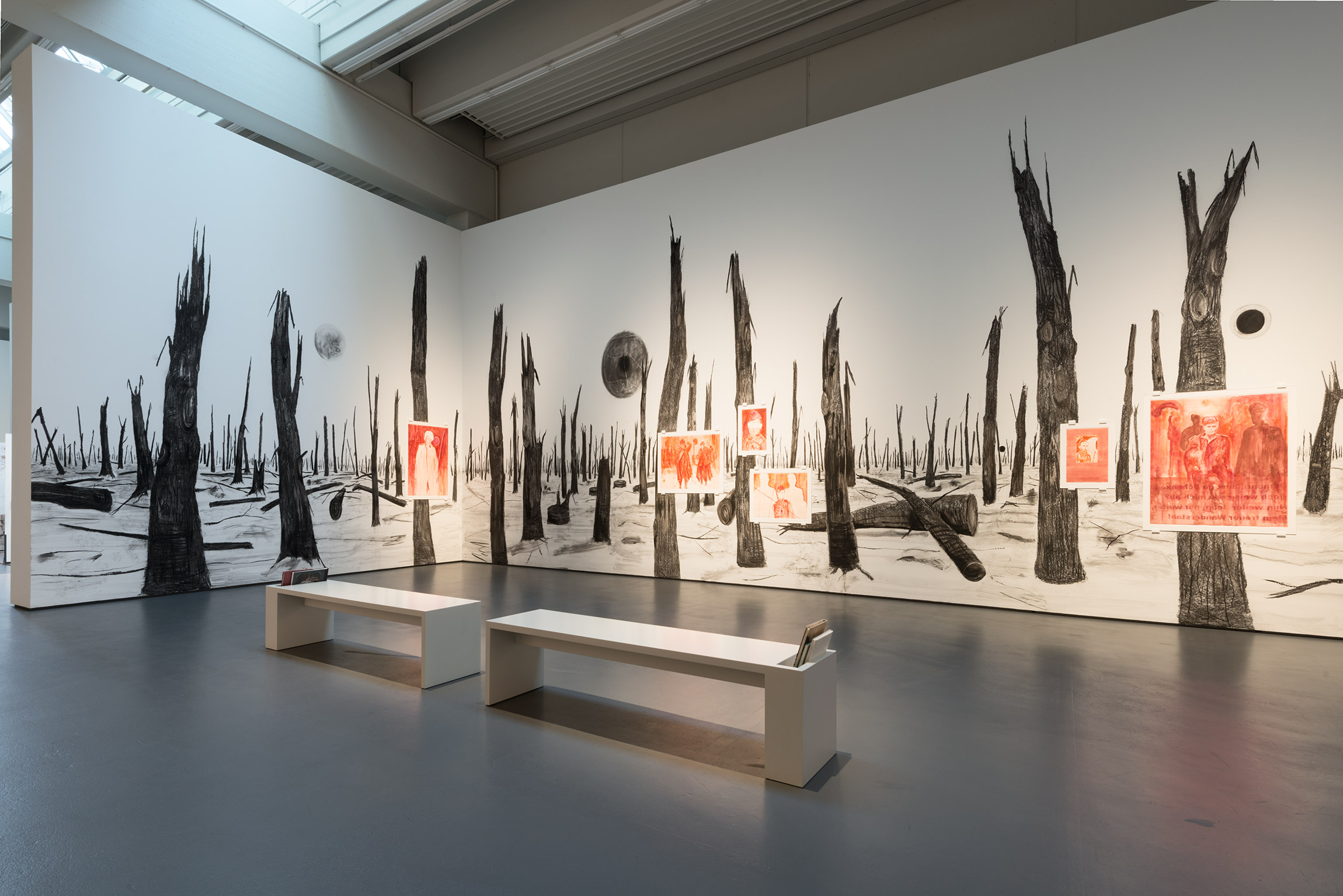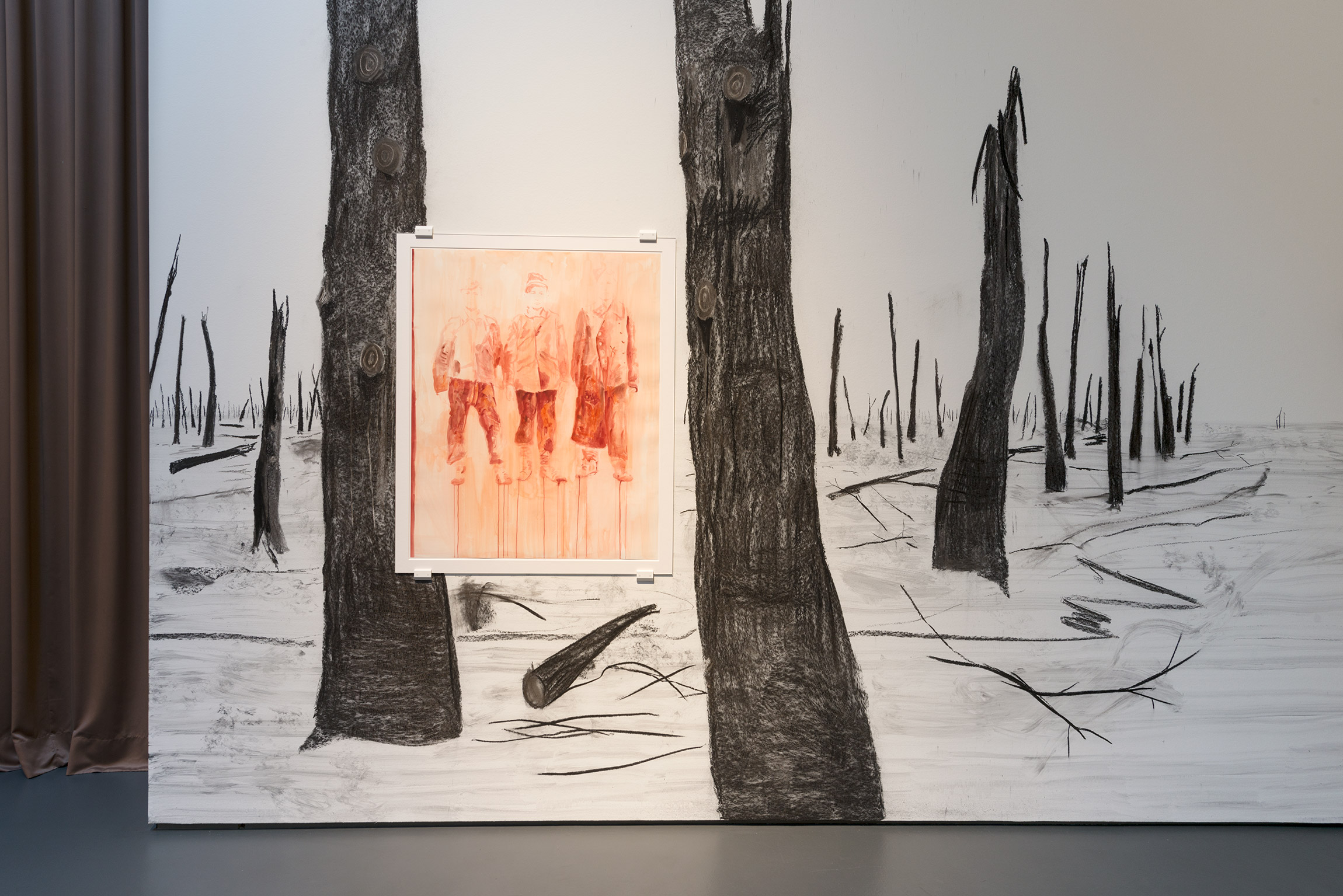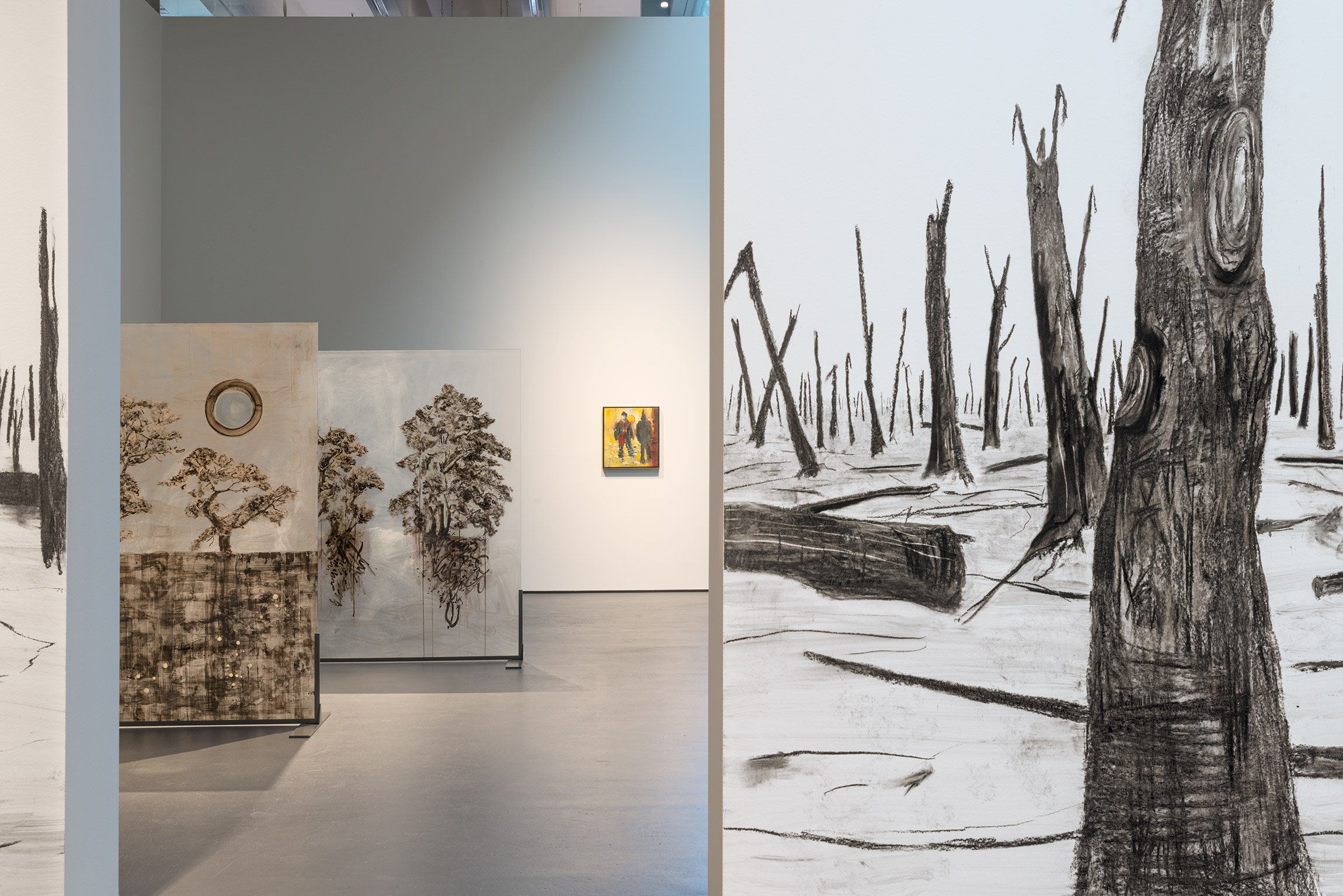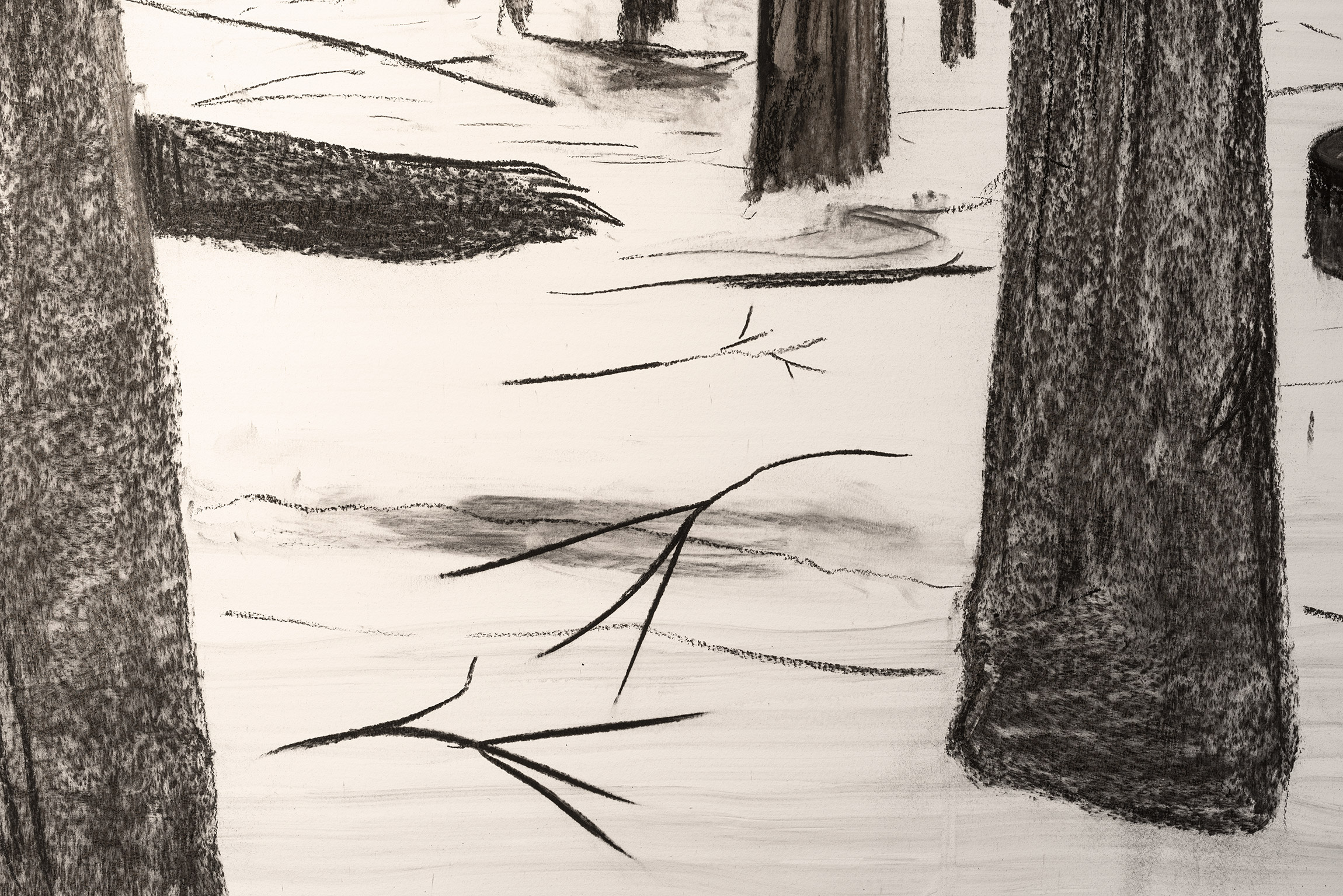Uwe Wittwer
Schwarzer Schnee
Works

Erster Wanderer
2021
Watercolor on paper
50.7 × 35.8 cm

Dritter Wanderer
2021
Watercolor on paper
50.7 × 35.8 cm
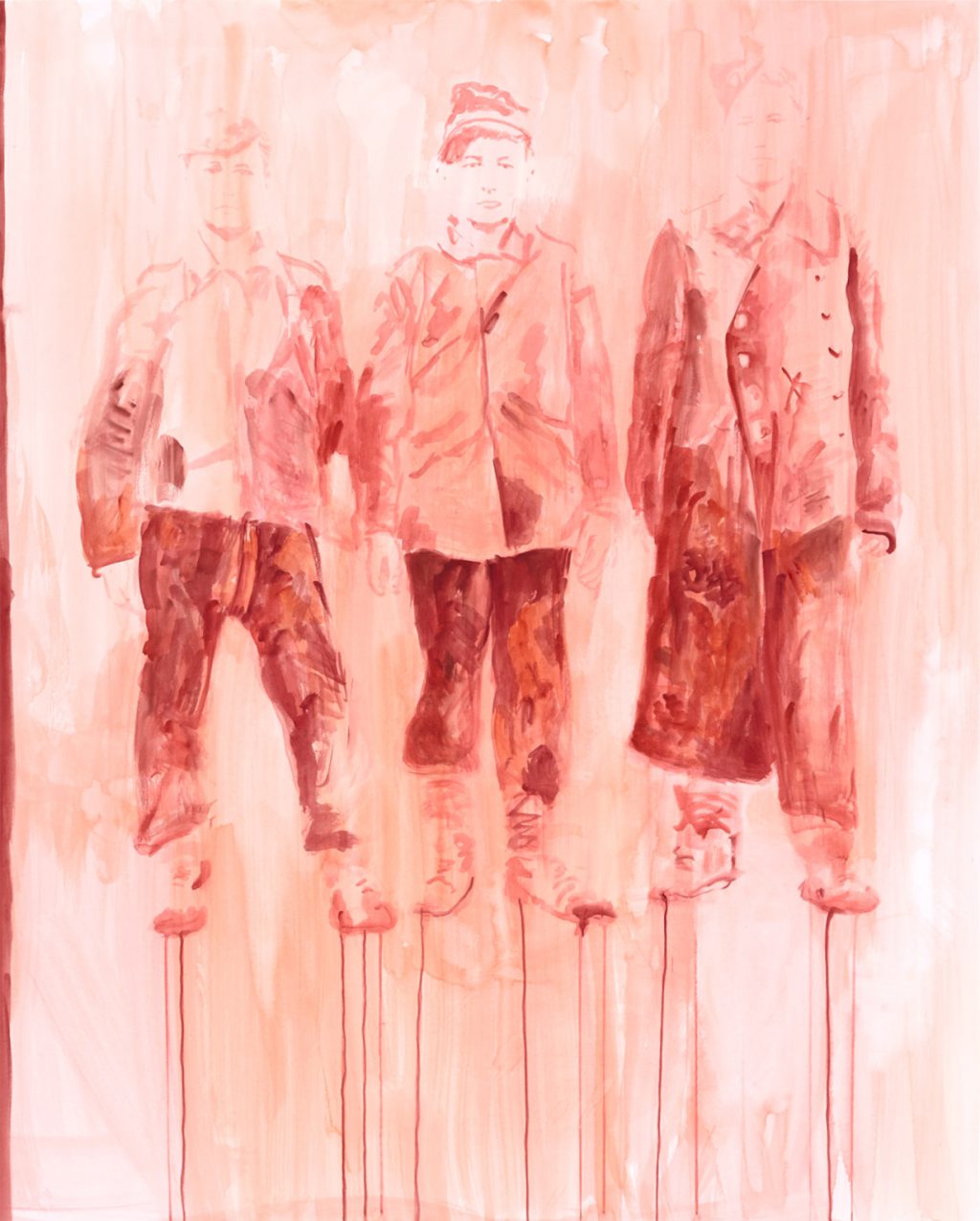
Zehnter, elfter und zwölfter Wanderer
2021
Watercolor on paper
111.3 × 89.7 cm

Dichtgedrängt nach Schongauer
2021
Oil on canvas
195.5 × 340.5 cm

Im Walde nach Dürer
2021
Charcoal on paper
150 × 134 cm

Die Ernte
2021
Oil on canvas
40.2 × 50.4 cm


Wanderer trifft auf eigenen Schatten
2021
Oil on canvas
55.4 × 50.5 cm

Aufkommender Schnee
2021
Oil on canvas
40.1 × 50.5 cm

Erste und zweite fragile Eiche nach Friedrich
2021
Glass, painted and burned, painted metal stand
200 × 150 cm

Neunte fragile Eiche nach Friedrich
2021
Glass, painted and burned, painted metal stand
200 × 150 cm
Text
With Schwarzer Schnee (Black Snow), Uwe Wittwer is already staging his sixth show in Berlin – and the term “staging” is chosen with care: all Wittwer exhibitions have had an installational character; never have paintings been simply lined up on the walls in a traditional way. This is primarily owing to the fact that the artist thinks and paints in series and becomes so absorbed in them that their numerical quality poses a challenge for almost any exhibition space. In addition, he has been working in highly contrasting techniques and a wide range of formats for years, and likes to combine them to individual groups of works – or sometimes fuse them into completely new and unconventional artistic vehicles. This is what happened recently with paintings fired in an elaborate process onto free-standing panels of glass, which, despite the robustness of the material, look like watercolors dabbed into the room. Wittwer has, however, never deviated from his central artistic strategy, which transcends techniques and materials: the questioning of pictorial reality and effect – a question that has gained dramatic urgency in our increasingly digitalized world. Unaffected by this, Wittwer’s paintings develop a beauty and sensuality that do not release the viewer from their pull, even when the dark themes of many works – violence, war, and death – become apparent to him.
Continue reading
This is also true of the new exhibition, whose title “Black Snow” may at least serve as a warning to us that the forest we are about to enter in the first space is by no means an idyll. We stand between the aforementioned man-high glass steles on which Wittwer has painted delicate trees, branches, and roots, for which Caspar David Friedrich’s pencil studies of oaks served as models. But dusky suns and black snowflakes strip the scene of the nature-yearning of German Romanticism, in which the forest was a place where God could be discovered, and peace found. A solitary, large-scale charcoal drawing confirms the gloom of this artificial forest: between charred tree stumps, a group of women mourns a dead man – a composition Wittwer borrowed from Albrecht Dürer’s Glimsche Beweinung Christi (Lamentation of Christ, around 1500), but with the addition of the apocalyptic forest has rendered it devoid of any old-masterliness. It is the forest as a place God has abandoned. This devastated forest in charcoal then receives us with a vengeance in the second space, now in the form of a 360° panorama, drawn by the artist directly on the walls. Hovering over crushed and scorched trees and black suns we see portraits painted in red of young men, children actually, in uniform. Only their pale faces and white bandages shine out of the watercolor applied with a broad brush. We can tell from their oversized uniforms and caps that they are Hitler’s “Letztes Aufgebot” (last resort) – child soldiers who were drafted in the last weeks of a war lost. The grit and utter sadness on the faces of these boys, standing in the ruins of Berlin, has long been burned into our collective memory. In Wittwer’s installation, we encounter them again as Wanderers, the title of these haunting portraits, in the charred forest – which now takes on a concrete, historical dimension: it is the Hürtgen Forest in the northern Eifel, where the Germans engaged the U.S. Army, advancing from the west, in a long and harrowing battle. The topography of this area and the dense pine forest enabled the Germans, including many child soldiers, to fight a bloody standoff despite being outnumbered. The forest as ally and enemy at the same time, as a place of retreat for some and as a place of terror for others – Wittwer’s panorama tries to express all this in only two colors, black and red. Ernest Hemingway, who was on the scene as a war reporter, later put the horror in these words: “In Hürtgen they just froze up hard; and it was so cold they froze up with ruddy faces. Very strange.” Like every Swiss, Uwe Wittwer knows the Bourbaki Panorama in Lucerne, a painting of 1,000 m2, created in 1881. It shows a defeated army of the Franco-Prussian War of 1870/71, in a vast, gloomy snowy landscape. Nature and especially the forest occupy a central place in Wittwer’s oeuvre, not only in this installation. An exhibition in our gallery ten years ago was entitled Andere Orte – Wäldchen (Other Places – Small Forest.) In the autobiographical exhibition Der Brief (The Letter) in 2013, a pivotal work was called Waldstück negativ (Forest negative). It features Uwe as a boy gathering firewood with his father in an impenetrable forest. This father had spent World War II in Berlin and fled to Switzerland only in February 1945, when the Nazis were turning children into soldiers. Wittwer found the templates for the touching faces of the doomed youths on the Internet – and we learn that he has admitted not only German but also Soviet child soldiers into his forest. To this day, children fight adults’ wars in forests, albeit in Africa. Perhaps that’s why Wittwer’s installation seems so timeless.
